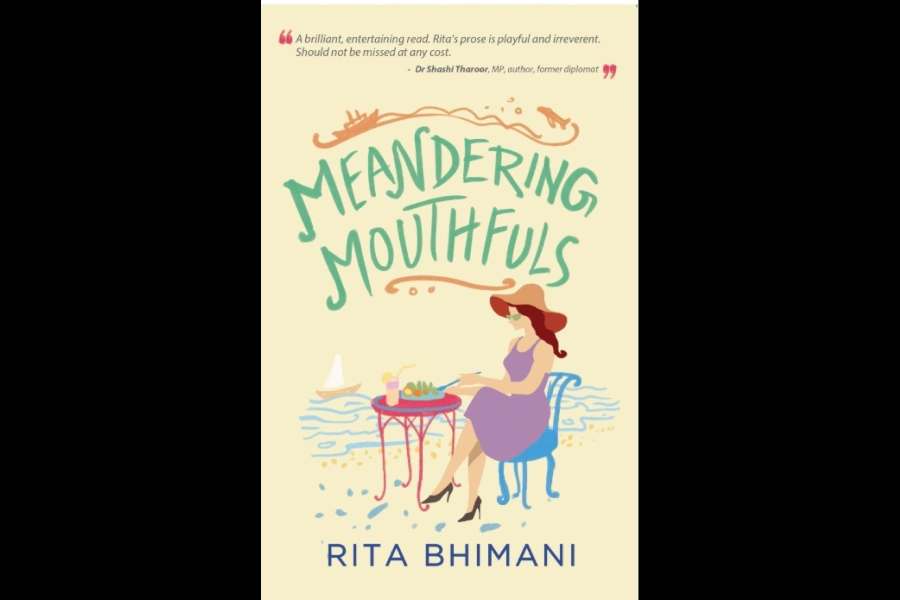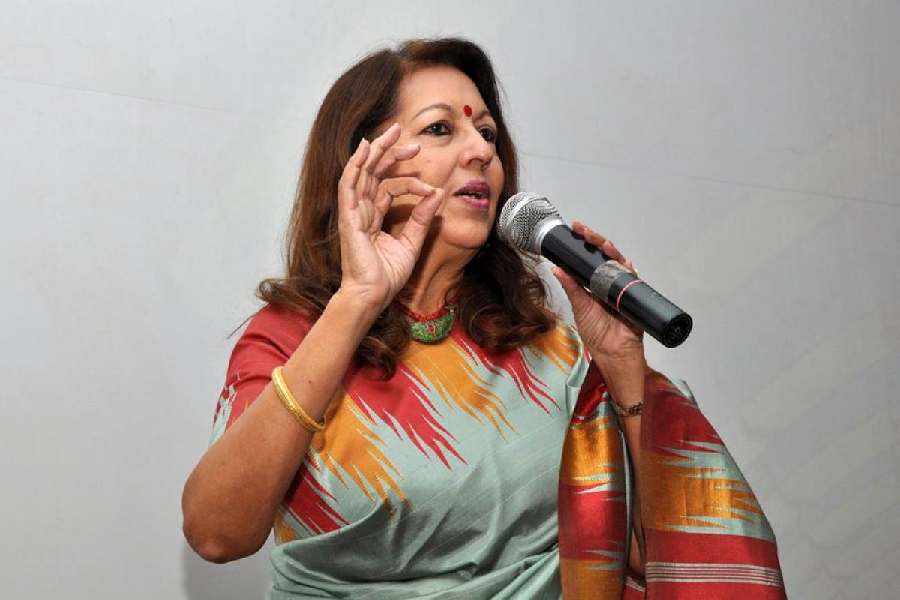The eating of ileesh has challenge and charm
The deboning process can disrobe and disarm
The taste is acquired
In ritual it is mired
In the fish world it stands out as noble Nizam
— Rita Bhimani in Meandering Mouthfuls
Rita Bhimani is a name synonymous with the public relations industry in Calcutta. A Calcutta girl who forged her place as a trailblazer, defining the history and geography of this sunrise discipline in the ’70s with her firm yet warm persona, Rita is also a compelling, light-handed writer, with six non-fiction books to her credit.
Having known Rita’s mother, Tapati Mookherji, whom most of us students of creative writing called Tajudi, well, I have little doubt that Rita’s mum’s gregariousness, generosity of spirit, and love of food, seeped into Rita’s core. Rita confesses: “Since you knew ‘Tajudi’ you will understand what a dynamo she was! She devoted more time to her short stories, poetry, and novels than to the kitchen, but found plenty of vim to encourage me to write, from the age of six. It was because of her that I got to submit my entries to Shankar’s Children’s International competition, and got piles of books as prizes, culminating in a vice-president’s gold medal when I was just 15.”

Meandering Mouthfuls, her newest book where she expertly juggles food and travel, is a delicious smorgasbord; a fascinating conceptualisation of foodways. Rita adds a novel dimension to culinary journeys by using a fusion of travel, cultural history, and national histories of cuisines and recipes. How did she conjure this fusion of genres so effectively and powerfully? “Somehow, these elements came together seamlessly. Just picking one genre would not have resonated with readers as books abound on travel, on culinary capability, and historic heft, so perhaps in combination, these elements came together as a one-pot meal,” she says. Here’s more from the author of Meandering Mouthfuls.
You have a rare gift of understanding human beings through one of the most important markers of identity — food. How can food speak to differences between people at war? Especially now in a world torn asunder where Palestinians and Jews share the same food, and Ukrainians and Russians, too, for instance.
This is a googly question, but a very relevant one in these times. Food I feel has a proximity angle, so it applies to Palestinians and Jewish people sharing the same food. In a war situation, when food depletes, problems arise. There are those who control it, and those who are deprived. But I feel we should look at the areas where religious bias comes in. While food, as you say, is a great leveller, you have to tread carefully about not hurting religious sentiments. I remember in my student days when I worked in a Jewish community centre, and saw how meat and milk were never to be mixed and I recall it to this day when an invite comes from a particular household that I have to know what to do. This is a very relevant question in these conflicted times.
It is the food similarities that are a major binding factor. One found Greek and Turkish food with pretty much the same items like dolmas and kebabs and yoghurt dips. So when things normalise after all these decades, it could be food that levels it all, sweetened with baklavas.
Was there also an inner journey that emerged as you began to revisit your travels?
Frankly, the book wrote itself. This tome goes back and forth in time, so there is nothing linear about it. I do not put pen to paper, but can think best on the computer when the images just come flooding back. In my typewriter days, my first draft had to be the final draft, when my food column was written. And so it has been with this book — you start writing and then the countries leap out at you.
Your chapters on places, specifically Georgia, Sri Lanka and South Africa were organic and married your personal experiences with people, even a game like cricket, and forged your bonds with friends you made.
Georgia... ah! Still on my mind as the song goes. It was aeons ago that I went to Georgia to do my Masters in journalism. Some of the food there was completely alien to me, like Grits, a corn-based porridgy item that we would have with eggs for breakfast, and biscuits freshly baked in a friend’s home with gravy slathered over it, but these came to be comfort favourites. Sri Lanka and South Africa both have the cricketing associations. At the latter country we launched a cricket book during the Cricket World Cup in 2003.
When you began to write Meandering Mouthfuls, did you have to work at retrieving stories from your memory? Was it difficult to remember your journeys?
I love being footloose on my travels and hence the experiences have been tucked away in a memory bank which I started trawling once the book got going. It was not easy I can assure you, for as you say, memory is unreliable. But you taunt and tease out what you want to record in writing and it sometimes comes out in a gush.
Your execution of the plan to include some of your close friends and associates and build an entire section on friends and their outstanding recipes is a kind of homage to women who are stalwarts. Why do you think so few women receive the kudos they so deserve for the excellence they achieve in the kitchen?
The book has a chapter on ‘Cookery Queens’. Since it is male chefs who are tom-tommed at the forefront, I chose to highlight women who have made a mark. From Kishwar Chowdhury, the MasterChef Australia finalist, to Babli Mukerji who has written several cookbooks (the great-granddaughter of C.R. Das), and continues to cook in her 80s, and from Sneha Singhi, the youngest who is an Internet culinary sensation, to remembering friends like Rakhi Purnima Dasgupta. Again, incorporating friends’ recipes in a chapter titled ‘A Baker’s Dozen’ — Afroze Randerian with her biryani special, Seema Sapru with her Kashmiri Methi Goli, Jewish Bamia Khatta by Jael Silliman, Turkish Kuru Kofte by Nilufer Bose Archment, and Usha Uthup’s Beef curry for Jani — there’s some titillating stuff awaiting readers.
Your book covers a huge number of culinary geographies and histories. However, your heart is with Hilsa. Your chapter on ‘The Glory of Ileesh’, and its remarkable magical inventions from polao to smoked steaks, is riveting. Which are your three most favourite Hilsa dishes?
Don’t get me started on the subject of Hilsa or Ileesh. I just adore that silvery snapper, and not only can write reams on it, and pen paeans in poetry about Hilsa, but love it in every possible form. From the steamed Hilsa on a steamer on the Padma, to the whole baked fish (executed by Lita Samad and described in detail) to smoked Hilsa, and every Bengali way of dealing with it, and then finding how the Sindhis love their Pallo and Hilsa roe to die for. Chef Narayan, who is no more, would wrap it in an edible lauki leaf, and make a marvellous Hilsa biryani, which I would subsequently replicate and take every year to the UK for friends, once even going through the red channel without flouting rules, which allowed cooked fish.
Julie Banerjee Mehta is the author of Dance of Life and co-author of the bestselling biography, Strongman: The Extraordinary Life of Hun Sen. She as a PhD in English and South Asian Studies from the University of Toronto, where she taught World Literature, Foodways, and Postcolonial Literatures for many years. She currently lives in Calcutta where she teaches Master’s English at Loreto College, is a t2 columnist, and curates The Rising Asia Literary Circle

